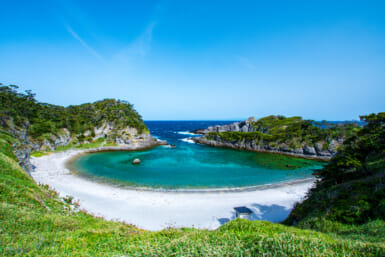by Lee Dobson
For generations, thousands of Japanese have made the pilgrimage from their hometown to that granddaddy of all shrines, Ise-Jingu on the Shima-hanto Peninsula in Mie Prefecture. For those of you unfamiliar with Western Honshu, Mie Prefecture—with its coastline meeting the Pacific Ocean—is found just below Gifu and Aichi Prefectures.
It was the dream of every Shinto-practicing family to visit Ise-Jingu at least once in their lifetime. Of course, not everyone had the time or the money to afford such a trip, so in many cases one family member would make the pilgrimage or holy journey to Ise. This New Year I decided to visit it, along with approximately three million other “pilgrims” to participate in Hatsumode, the first prayers of the New Year.
Ise’s grand shrine is Japan’s most venerated Shinto place of worship, and dates back some 2,000 years. It is located at the foot of Mount Kamiji and Mount Shimaji alongside the Isuzu River. The surrounding area is a national park and houses wonderfully tall cryptomeria trees and the evergreen sasaki, a shrub closely related to the tea bush.
According to Shinto beliefs, both species of flora are considered sacred. They are thought to host ke, which is the mysterious and unseen force of nature believed to inhabit palpable matter such as trees and rocks. The name for this unseen “spirit” is mononoke or the “natural spirit of inanimate objects.”
While the area had long been held sacred, it wasn’t until Emperor Temmu (678-686), the first Mikado to rule over a united Japan, declared it so, that the shrine was considered the principal Shinto place of worship and achieved its current cult-like status. After his death, his wife—then Empress Jito—first reconstructed the temple in 692, and it is from those structures that the present buildings are reproduced. Shinto law dictates that the temple structures (all 200 of them) must be rebuilt every 20 years. Reconstruction was last completed in 1993, the 61st such restoration.
The reason for this periodic rebuilding is still somewhat unclear, although the official theory is that it provides an opportunity for traditional carpentry methods to be kept alive. It may also be related to the fact that Shinto practitioners considered the Emperor’s residence to be defiled by death and as such after each death palaces were often razed and rebuilt. Considering the connection between the Imperial family and Shintoism, it’s feasible that this belief could have carried over to include Shrines.
The fact remains, however, that it does indeed provide the means to keeping Japan’s traditional carpentry skills alive. Most of the labor and knowledge is provided by local craftsmen whose families have generations of experience with the tools and know-how necessary for a successful completion. There are no nails used to construct the pavilions; each piece is meticulously carved and shaped so as to interlock with another.
While plans are available, most carpenters work from memory and pass these skills onto their apprentices over a period of 10 to 12 years. However it may be 20 or more years before apprentices actually get to utilize these skills on anything more elaborate than cleaning or general labor. Construction generally takes about eight years to finish, with a special ceremony occurring at the completion of each building.
Ise-Jingu is divided into two, an inner shrine and an outer shrine. Geku, the outer shrine, dates back to the 5th century and houses the goddess Toyouke-no-Okami, quite literally “the great deity of cereals”—or better known as “the goddess of abundant food and clothing.” While not quite as spectacular as the inner shrine, it is worth a look. Information and maps in English are available from a stall located at the entrance. The entrance is approached from a tree-lined avenue and surrounded by a closely fitted wooden fence. Unfortunately, you have to be content with a lot of neck-craning to get even a glimpse of the inner sanctum, as entry is not permitted.
If you are desperate, for the princely sum of ¥5,000, you can get in to the outermost of the four enclosures. While most pilgrims are content to pray outside the four walls, those with a particularly important wish can pay the price and offer their prayers inside the first enclosure.
If you have the opportunity, it is well worth watching the practice that occurs. Also note the size of the priests’ footwear, and you will understand where the latest trend of platform shoes really comes from.
After paying the fee, the visitor consults with a priest; he or she is then “purified” with salt and led inside the enclosure. While the priest waits patiently, the worshipper offers his prayers with a long period of bowing and clapping. If you have observed prayers at a smaller shrine, it becomes immediately obvious just how much esteem is placed on worshipping here.
Of the two, Naiku, the inner shrine, is perhaps the more spectacular. It is here you have the opportunity to come face to face with Amaterasu-no-Omikami, the “heaven-illuminating great deity,” commonly known as the “sun goddess.” Her position is very auspicious as she is considered the ancestral goddess of the Imperial family and the guardian deity of Japan. Naiku is held in greater esteem than Geku because it houses the sacred mirror of the Emperor, one of the three imperial regalia (the other two being the curved jewels and the sacred sword.)
Since the mirror’s enshrinement in the 3rd century, it hasn’t been looked upon by ordinary people, with only the Imperial family having the right to do so. Only time will tell if one of the royals decides to sneak a peek. To prevent the mirror from being “soiled” by human gaze, it is covered with a brocade bag. When the bag wears thin, it is simply covered with another bag. While it may be pure speculation, legend has it that the back of the mirror is inscribed with ancient Hebrew.
At the entrance to the shrine, you will again find a stall offering the same information pamphlet in English as the stall in Geku. Immediately to the right of that you cross the Uji Bridge that leads over the small and crystal-clear Isuzu River. After passing under the huge Torii gate, you follow the wide stone-covered path leading up to the shrine.
The walk itself is pleasant, as the path winds its way through the pristine gardens and groves of towering cryptomeria trees. To the right of the path, you will come across a small pond that pilgrims once used to cleanse themselves before offering their prayers. Many still follow this ritual, although it isn’t easy as the pond is teeming with colorful carp, all waiting for a handout.
A further five-minute walk and you arrive at the outermost of four wooden fences, with a series of stone steps leading up. From this point on, no photographs are allowed. During Hatsumode, visitors are allowed inside the first enclosure to offer their New Year prayers. The line is divided into two at the bottom of the stairs, with serious worshippers entering to the left, and those in a hurry entering to the right. Being in the line on the right, I am unsure what constitutes a “serious prayer,” but I imagine it would be much the same as the ritual I witnessed at Geku previously.
To best view the shrine, approaching from its Western side affords you the opportunity to see the buildings, which in the midday sun are almost as bright as their gold-tipped roofs.









